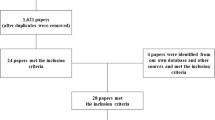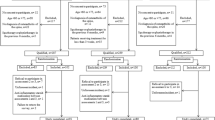Abstract
Study design: Assessment of spasticity before and after hippotherapy treatment.
Objective: To evaluate the short-term effect of hippotherapy on spasticity of spinal cord injured patients (SCIs).
Setting: Swiss Paraplegic Centre, Nottwil.
Methods: 32 patients with spinal cord injury with various degrees of spasticity had repeated sessions (mean 11) of Hippotherapy-K®. Spasticity of the lower extremities was scored according to the Ashworth Scale.
Results: In primary rehabilitation patients Ashworth values after hippotherapy were significantly lower than before (Wilcoxon's signed-rank test: P<0.001). Highest improvements were observed in SCIs with very high spasticity. No significant difference between short-term effect in paraplegic and short-term effect in tetraplegic subjects was found.
Conclusions: Hippotherapy significantly reduces spasticity of lower extremities in SCIs.
Similar content being viewed by others
Log in or create a free account to read this content
Gain free access to this article, as well as selected content from this journal and more on nature.com
or
References
Lance JW . Symposium synopsis. In: Feldman RG, Young RR, Koulla WP (eds). Spasticity: Disordered Motor Control. Yearbook Medical Publishers: Chicago 1980, pp 485–494.
Levi R, Hultling C, Nash MS, Seiger A . The Stockholm Spinal Cord Injury Study: 1. Medical problems in a regional SCI population. Paraplegia 1995; 33: 308–315.
Skold C, Levi R, Ake S . Spasticity after traumatic spinal cord injury: nature, severity and location. Arch Phys Med Rehabil 1999; 80: 1548–1557.
Exner G, Engelmann A, Lange K, Wenck B . Grundlagen und Wirkung der Hippotherapie im Konzept der umfassenden Behandlung querschnittgelähmter Patienten (German). Rehabilitation 1994; 33: 39–43.
Hegemann D, Zäch G . Hippotherapie zur Behandlung der Spastizität bei Para- und Tetraplegikern (German). In: Grueninger W (ed). Spinale Spastik. Ueberreuter Verlag: Stuttgart 1989, pp 147–149.
Bertoti DB . Effect of therapeutic horseback riding on posture in children with cerebral palsy. Phys Ther 1988; 68: 1505–1512.
Wuethrich R, Kuenzle U . Hippothérapie chez des patients atteints de sclérose en plaques. J Beige Med Phys Rehabil 1978; 1: 265–268.
Strauss I . Hippotherapy: Neurophysiological Therapy on the Horse. Ontario Therapeutic Riding Association: Thornhill, Ontario 1995.
Ashworth B . Preliminary trial of carisoprodol in multiple sclerosis. Practitioner 1964; 192: 540–542.
Maynard FMJ et al. International standards for neurological and functional classification of spinal cord injury. American Spinal Injury Association. Spinal Cord 1997; 35: 266–274.
Kuenzle U . Hippotherapie auf den Grundlagen der Funktionellen Bewegungslehre Klein-Vogelbach. Hippotherapie-K: Theorie, Praktische Anwendung Wirksamkeitsnachweis. Springer-Verlag: Berlin Heidelberg, 2000.
Sheskin DJ . Handbook of Parametric and Nonparametric Statistical Procedures. 2nd edn. Chapman & Hall/CRC press: Boca Raton, 7L 2000.
Kuenzle U, Wuethrich R . Schweizerische Studie über die Wirksamkeit der Hippotherapie K bei Multiple-Sklerose-Patienten. In: Kuenzle U (ed). Hippotherapie auf den Grundlagen der Funktionellen Bewegungslehre Klein-Vogelbach. Springer-Verlag: Berlin, Heidelberg 2000, pp 359–381.
Weber A . Hippotherapie bei Multiple-Sklerose-Kranken. Ther Reiten 1994; 21: 16–19.
Tarnow A . Hippotherapeutische Behandlungsergebnisse – Versuch einer Dokumentation der Therapieerfolge (German). Oeff Gesundh Wesen 1979; 41: 201–205.
McGibbon NH, Andrade CK, Widener G, Cintas HL . Effect of an equine-movement therapy program on gait, energy expenditure, and motor function in children with spastic cerebral palsy: a pilot study. Dev Med Child Neurol 1998; 40: 754–762.
Acknowledgements
We thank all the subjects who participated in the study and we gratefully acknowledge the financial support of the Swiss Paraplegic Foundation.
Author information
Authors and Affiliations
Rights and permissions
About this article
Cite this article
Lechner, H., Feldhaus, S., Gudmundsen, L. et al. The short-term effect of hippotherapy on spasticity in patients with spinal cord injury. Spinal Cord 41, 502–505 (2003). https://doi.org/10.1038/sj.sc.3101492
Published:
Issue date:
DOI: https://doi.org/10.1038/sj.sc.3101492
Keywords
This article is cited by
-
Effects of therapeutic horseback riding on post-traumatic stress disorder in military veterans
Military Medical Research (2018)
-
Study of the therapeutic effects of an advanced hippotherapy simulator in children with cerebral palsy: a randomised controlled trial
BMC Musculoskeletal Disorders (2010)
-
Equine-assisted therapies: Complementary medicine or not?
Journal of Outdoor and Environmental Education (2009)
-
Spasticity outcome measures in spinal cord injury: psychometric properties and clinical utility
Spinal Cord (2008)



